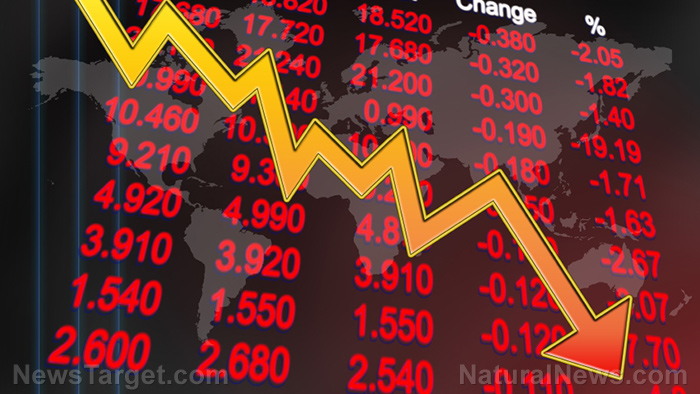Trump’s tariff shockwave sends Wall Street reeling as global recession fears mount
- President Donald Trump’s announcement of steep tariffs on imports sparked a massive sell-off on Wall Street, with the Dow Jones plummeting 1,700 points and the S&P 500 experiencing its worst day since June 2020.
- The Nasdaq dropped nearly 6 percent, while the small-cap Russell 2000 index entered bear market territory, down 21 percent from its November high.
- Trump remains unfazed, predicting a market boom and asserting that the tariffs will bring billions of dollars into the U.S. economy.
- The tariffs, ranging from 10 to 54 percent, will impact countries like China, the European Union, and Asian nations, potentially leading to higher prices for consumers and retaliatory measures from trading partners.
- The Federal Reserve has indicated no plans to alter its interest rate policy in response to the market turmoil.
A day of reckoning on Wall Street
In a dramatic turn of events, Wall Street experienced its most tumultuous day since the height of the Covid-19 pandemic, as President Donald Trump’s announcement of sweeping tariffs on imports sent shockwaves through the global economy. The Dow Jones Industrial Average plummeted by 1,700 points, marking a 3.98 percent decline, while the S&P 500 suffered its worst day since June 2020, shedding 4.84 percent of its value. The tech-heavy Nasdaq Composite fared even worse, dropping nearly 6 percent.
The sell-off was widespread, with only one stock gaining value for every six that lost ground. Major companies like Five Below, Gap, Ralph Lauren, and Nike saw double-digit percentage declines, while Apple, a bellwether for the tech sector, dropped 10 percent. The small-cap Russell 2000 index, a key indicator for smaller, U.S.-focused businesses, plunged 5 percent, pushing it into bear market territory with a 21 percent decline from its November high.
Trump’s unfazed confidence
Despite the market turmoil, President Trump appeared unperturbed. As he boarded Air Force One to attend a golf dinner in Miami, he told reporters, “I think it is going very well.” He likened the situation to a surgical operation, stating, “It was an operation. [It is] like when a patient gets operated on and it’s a big thing. I said this would exactly be the way it is.”
Trump expressed optimism about the future, predicting that “six or seven trillion” dollars would flow into the U.S. economy and that the markets and the country would soon boom. He also hinted at the possibility of negotiations, suggesting that other nations might seek deals with the U.S. to avoid the tariffs.
The tariffs, which will take effect on April 5, include a baseline 10 percent rate on all imports, with higher rates for specific countries. China will face a 34 percent tariff on top of an existing 20 percent, while the European Union will see a 20 percent tariff. Other nations like South Korea, Japan, and Taiwan will face tariffs ranging from 24 to 32 percent. The highest tariff, at 50 percent, will be imposed on imports from the African nation of Lesotho.
Trump justified the move by accusing foreign nations of “ripping off” the United States, claiming that the tariffs were necessary to protect American interests. He condemned “foreign scavengers” and “cheaters” who had “pillaged, raped, and plundered” the U.S., and he promised that the tariffs would bring factory jobs back to America.
However, the move has raised concerns about potential retaliatory measures from trading partners and the impact on American consumers. Retail experts warn that the tariffs will likely lead to higher prices for goods, as companies pass on the increased costs to customers. This could exacerbate inflation and put a strain on household budgets.
Market reactions and Federal Reserve stance
The market reaction was swift and severe, with futures tied to major U.S. indexes nosediving overnight as investors grappled with the prospect of rising inflation and economic uncertainty. Global stocks also tumbled, with Japan’s Nikkei index sinking more than 3 percent and Australia’s main index heading for its worst single-day decline since September.
Wall Street had hoped that the sharp sell-off would prompt the Federal Reserve to cut interest rates to stimulate the economy. However, Fed member Philip Jefferson indicated that the central bank had no plans to alter its policy of two planned cuts for 2025. This stance suggests that the Fed believes the current market correction is a temporary adjustment rather than a sign of a deeper economic downturn.
Trump’s tariff strategy is part of a broader economic plan that aims to reshape global trade dynamics and bring manufacturing back to the United States. While the president has promised that the tariffs will ultimately benefit the U.S. economy, critics argue that the move could backfire, leading to a sudden economic slowdown as consumers and businesses face higher prices.
Commerce Secretary Howard Lutnick dismissed the possibility of exemptions for certain countries, stating, “I don’t think the word exemption is going to be a factor.” He warned that other nations would be making a mistake if they retaliated with their own tariffs against the U.S.
At the end of the day, the markets are on the trajectory for a correction, and a recession is looming. The endless funds that were used to prop up a phony economy are being washed away now, and America will be faced with economic realities. You can’t print your way to economic success. At some point, people and businesses have to produce something of tangible value. The new direction will be painful for many.
Sources include:
Dailymail.co.uk
Dailymail.co.uk
Enoch, Brighteon.ai
Read full article here


